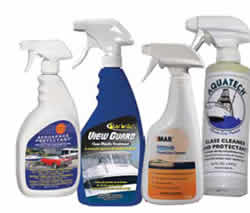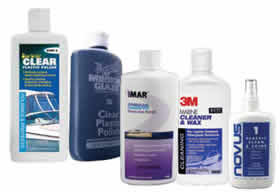Photos by Drew Frye and courtesy of manufacturers

As any boat owner can attest, theres no better view than the one from the helm underway. But as time and UV exposure yellow and stiffen the windows on our dodgers and biminis, that view approaches something akin to squinting through cataracts. Regular cleaning with a soft cloth can help keep the vinyl in decent shape-we reviewed products for cleaning and restoring slightly weathered vinyl windows in the March 2009 issue-but what really helps over the long run?
PS tester Drew Frye recently had to replace his hard-top dodgers forward and side Strataglass windows for the second time. (Each time they lasted seven years.) Yet the dodgers original, 16-year-old skylights were still like-new, clear and supple. So why the difference? The skylights had spent most of their lives under Sunbrella covers, shaded from harmful UV rays. We also noticed that the damage was at its worst right at the window base, where reflection from the deck and dashboard intensified the exposure. With this in mind, Frye rigged a canvas awning to protect his shiny, new Strataglass windows from UV and bird poop, and PS launched a test to find the best products that would protect the Strataglass from oxygen and moisture (vinyl hazes in damp weather). This long-term test focuses on preventing vinyl degradation for the long haul through proper care using the right products-rather than relying on restorative products or having to replace the windows prematurely.
What We Tested
The two main types of vinyl protectants are spray cleaners, which should be applied monthly, and creams or pastes, which can be applied quarterly-ish. The easy-to-use sprays are formulated for cleaning and shine, but the creams and pastes have a more substantial film and take a little more time to apply-in part because the windows must be cleaned first.
There are also aerosol cleaners such as Plexus Plastic Polish and Armada 210. These perform very well in the short term, but the Strataglass manufacturer firmly states that the products, which contain about 20- to 30-percent petroleum solvents, can cause hazing if used regularly. Based on our limited compatibility testing, we believe it. The solvents can remove protective coatings, leech surfactants, promote crystallization of the polymer (hazing), and delaminate the coating (orange peel or haze). The solvents in the pump-spray products we tested are generally more gentle alcohols.
This test field includes products that are endorsed by clear-vinyl manufacturers like Strataglass, as well as similar products with good reputations and a few products recommended by fellow boat owners. To our knowledge, Imar Products makes the only Strataglass-endorsed maintenance products for Strataglass-brand vinyl-and according to the canvas professionals we talked with, Imar products are known for working well. From Imar, we tested Strataglass Protective Cleaner 310 spray and Strataglass Protective Polish 302 paste.
The rest of the field comprised sprays, creams, and pastes from 303 Products Inc., Star brite Inc., AquaTech Marine, 3M Marine, Meguiars, and Novus.
Testers applied each product to swatches of Strataglass and OSullivan Films (OSea, and Regalite) vinyl products, and evaluated their cleaning ability and ease of polishing, as well as the shine they produced. For specifics on our testing methodology, see How We Tested.

Spray cleaners
All of the spray-on protectants were easy to apply and fast to use, and the treated test panels held a brilliant shine after three months of testing.
The most effective water repellent of the spray products-so far-and a very close second to Star brites View Guard for the best cleaner in the pack was Imars Strataglass Protective Cleaner. At $1.56 per ounce, its one of the more expensive products we tested but its also the product that Strataglass makers require be used during the vinyls warranty period.
Performing much like Imars spray protectant (at half the price), the 303 Aerospace Protectant took a bit more time to polish, but only time will tell whether this was due to its having a higher concentration of protective ingredients.
A reasonably effective spray, Aqua-Tech Marines Glass Cleaner and Protectant provided some water repellency and polished easily. Beading did not last as long as it did with some other products. This product had been previously used on the test boats failed windows, so we will be watching this one closely.
A convenient spray cleaner/protectant, Star brites View Guard is formulated for vinyl windows and other plastic products. Testers noted that it had limited-duration beading, but it was the best cleaner of the group and polished to a nice shine very quickly. Both Star brite test products contain siloxanes, which appear to be the same ingredients that Imar uses. At 64 cents per ounce, View Guard is one of the least expensive protectants tested.

Protective Polishes
As it was with the spray products, ease of application among the creams and pastes was very similar, and all but one earned an Excellent for polishing ease. With the exception of the 3M Marine Cleaner and Wax, all went on easily and buffed to a good gloss very quickly after drying. The creams were just a little faster to apply than the Meguiars paste.
A standard marine wax, the 3M Marine Cleaner and Wax does a good job on weathered gelcoat, but it was more difficult to buff than other vinyl protectants and produced our only failure in this test. Note that 3M does not recommend this product for this application. We only tested it to illustrate the potential danger of using hull cleaner-waxes on vinyl windows. The 3M cleaner-wax contains fine abrasives, and although the first few applications looked good, with excellent water beading, by the fourth application, the vinyls surface hazing from fine scratches was quite noticeable. We suggest avoiding all cleaner-waxes that may contain abrasives.
A cleaner-wax cream, Imars Strataglass Protective Polish is the only polish Strataglass approves for use during the vinyls warranty period. The polish easily produced a mirror gloss, and testers noted that its among the most effective products for restoring gloss to vinyl. (We used it to resurrect the test boats Strataglass skylights and some frightfully neglected vinyl.) Although its the most expensive product tested, it would need to be applied only a few times each year.
Another creamy cleaner-wax, Star brites Clear is part 2 of a two-step vinyl restoration system. (Part 1 is a mild abrasive cream that is being tested for a separate article on scratch removal.) The Clear offered easy and bright polishing with good water beading.
A white cream, Meguiars Mirror Glaze 10 was one of the fastest to polish and gave long-lasting beading. Meguiar recommends the Glaze 10 for use on acrylic and polycarbonate, but it does not mention anything about using it on vinyl. However, it contains no abrasives and worked well. At $9 for 8 ounces, it was one of the more pricey creams we tested.
Meguiars Cleaner Wax has many fans who polish everything with it, or so it seems, and it has repeatedly done well in polishing and restoring slightly worn plastics. But does it remove the protective coating from Strataglass? Only time will tell.
The paste wax is easy to apply, easy to polish to high gloss, and provides extended beading. While were not going to recommend it for new vinyl windows at this stage in testing-too much is unknown-it might be a good, low-risk choice for older windows that could use some very gentle oxidation removal. This product has very fine abrasives, but unlike the 3M cleaner wax, it did not produce any scratching or hazing even after four applications.
Conclusion
This test-launch article is only a roll-out discussion with a few preliminary results. The really interesting findings may take months more, or even years, to unravel.
Which is better, a liquid or paste wax, or a spray? In the short-term testing, both provided increased beading if applied at the recommended intervals. Waxes are better at restoring mildly scratched vinyl-no doubt because there is more solid material to fill the grooves-and are expected to give better UV protection.
All of the products we tested-except the 3M Fiberglass Cleaner Wax, which produced visible scratches-were effective and easy to use. We like all of the vinyl protectants we tested based on results to date. The standouts so far include the two Star brite products, View Guard and Clear, which offer good performance, ease of use, and budget friendliness. The 303 Aerospace Protectant is also looking good.
Unfortunately, given the Strataglass manufacturers trenchant position and our lack of long-term data, we are holding off on issuing official recommendations for the products, except for the two reccommended by Strataglass. Until our testing is complete, we suggest a practical routine for the typical weekend/seasonal sailor: Use Imar Protective Cleaner in-season, when a boat is sailed and the windows are cleaned every few weeks, in combination with Imar Protective Polish in the spring, mid-season, and fall.
This test will continue for at least three years, with regular published updates. As we get further into the testing, we will compare clarity and stiffening, not just between protectants, but between different vinyl products. We will explore vinyl-window material options other than the typical marine standards, with a look at characteristics like clarity, flexibility over a range of temperatures, and long-term scratch resistance. We also plan to evaluate semi-rigid polycarbonate products like Makralon.


































